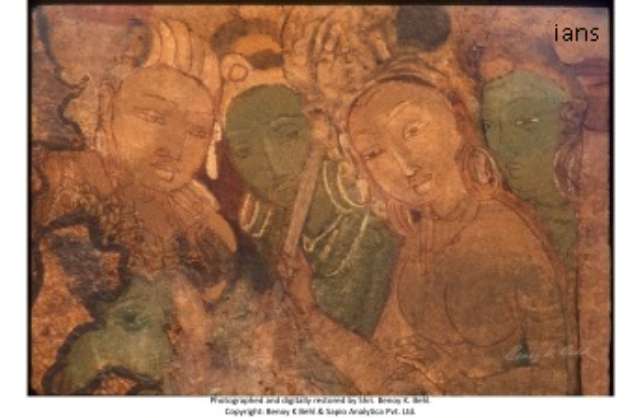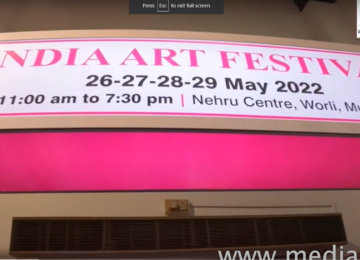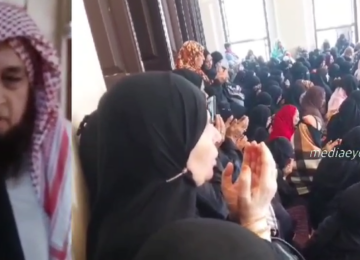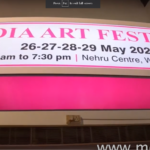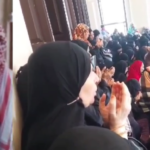Anupama Nair
www.mediaeyenews.com
India is famous for her ancient culture, religion, traditions, medicine, art and literature. You name it and we have it here. She is the “cradle of civilization”. The Indus Valley Civilization is the oldest urban civilization in the world. Hinduism or “Sanatan Dharma” is the oldest religion in the world. The word Hindu is an exonym (a name given to a place by foreigners) – called so by the Persians and Greeks used as a geographical, cultural, and later religious identifier for people living in the Indian Subcontinent around or beyond the Sindhu (Indus) river. Ironically, the name India itself is an exonym used by the Persians and Greeks.
Indian painting has a very long tradition and history, however, due to the climatic conditions very few exist today. The earliest Indian paintings, were the rock paintings of pre-historic times, such as the petroglyphs (a rock carving, especially a prehistoric one) found in places like Bhimbetka rock shelter (Madhya Pradesh). Some of the Stone Age rock paintings found there, are approximately 10,000 years old. Incredible India it is indeed! India's ancient Hindu and Buddhist literature has many references of palaces and other buildings decorated with paintings, but the paintings of the Ajanta and Ellora Caves are the most noteworthy of the few that still exist.
Indian paintings can be broadly classified as murals, miniatures and paintings on cloth. Murals are large works executed on the walls of solid structures, as in the Ajanta and Ellora Caves and the Kailashnath temple. Miniature paintings are executed on a very small scale for books or albums on perishable material such as paper and cloth. Traces of murals, in fresco-like techniques, survive in a number of sites with Indian rock-cut architecture, around 2,000 years, old, but ones in Ajanta—Ellora Caves are the most significant.
Paintings made on cloth, often produced in a more widespread context, was often used as folk art, used for example by travelling reciters of epic poetry, such as the Bhopas of Rajasthan and elsewhere in the country. We encourage such arts by purchasing them as souvenirs. Though these are not older than 200 years, it is known they are much older than that was believed.
In an epoch-making event marking the revelation of the lost traditions of ancient Indian art, the earliest surviving Hindu painting, photographed and digitally restored by Benoy K. Behl, was unveiled before a global audience in Mumbai last week. “One of the earliest surviving paintings in a Hindu temple – from the world-famous Badami Cave Temples – has been photographed, digitally restored and formally unveiled to a global audience”, said Mr. Behl proudly.
Behl enlightened top international dignitaries over two dozen global ambassadors, historians and art experts, the significance of the Badami Cave Temple and the sixth century painting – “Queen and her attendants” – which was declared as a UNESCO World Heritage site.
Behl explained how “Bharat has a continuous tradition of paintings, coming through ancient and medieval times” and he himself had documented Bharatiya paintings from the 2nd BC till 13th AD, and the lost ancient “Bharatiya mural painting styles”.
Behl stated, much of the Badami paintings, as described in the 1950s, were lost when he went to photograph them in 2001 AD, and seven years later, the National Geographic magazine could hardly see anything, when its team went there for a major story. “Therefore, this photography (of Badami) and the restoration are of considerable importance in the documentation of the tradition of Indian paintings,” Behl stated proudly.
I did some research on the painting “Queen and her attendants”, and made me proud of being a part of “Incredible India”. The Badami Caves, home to Hindu and Jain Cave temples are found in Badami (Northern Karnataka) and portray some of the oldest surviving painting depicting the culture of Hinduism. Unfortunately, majority of the paintings have deteriorated to such levels that it is impossible to interpret them.
The paintings of the “Queen and her attendants “ is the oldest of the existing paintings. Mr. Behl had to work hard to restore these paintings while ensuring they are not destroyed. He used revolutionary low-light photographic techniques innovated to capture the “ancient culture of India”. The painting depicts a Queen with her attendants, taking us back to the time when our Queens were famous for their beauty and valor.
Mr. Behl deserves much credit and a pat on his back for restoring the destroyed paintings of the bygone era. Hope he is able to restore more paintings and showcase our culture, tradition, art and literature to the world.

